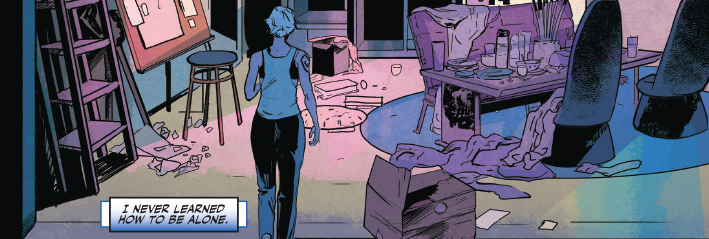Doctor Mirage #1 // Review
Shan Fong’s husband is dead. Shan used to be able to see the dead. So she could see her husband. Then the dead stopped hanging out with her. And the ghost of her husband disappeared too. She’s about to find out why in the first issue of the new Doctor Mirage mini-series. Writer Magdalene Visaggio writes a story drawn by Nick Robles. Color comes to the page courtesy of Jordie Bellaire. Visaggio weaves an interestingly novel, little opening chapter to a supernatural adventure which tilts the traditional ghost story on its head somewhere between Hell and everything else. It’s a very promising first chapter.
Shan Fong had been a TV star with her late husband magician. His death wouldn’t have kept him from her as she could always see and interact with the dead ever since she was a girl. Now she’s been forsaken by the dead and isn’t entirely certain if ghosts even exist anymore. She blows a reasonable part of her roof off while connecting-up with strange magics in the interest of reconnecting. A young stranger named Grace Lugo shows-up mentioning that she knows the ghost of her late husband. Grace has got news for Shan that’s not going to be easy to accept.
Visaggio plays with the paranormal with a whimsical mirror. Shan is starting over. Everything she has ever known has been destroyed. She just wants to be alone, with her husband. And all the rest of the ghosts which seem to have disappeared. A stranger who knows her late husband and can still talk to her is the LAST person she would want to be with. Visaggio builds a witty rapport between Shan and Grace that delivers the plot in a really, really interesting direction at the end of the first issue of what could be a very, very interesting Dante-esque mutation into the land beyond the living.
Robles’ layout is clever and breathtaking, but the art itself seems to fall into a sketchiness that can hold the drama at a bit of a distance. The moody emotions of a supernatural funk feel vivid enough, but without finer detail, it all feels like a dreamy kind of a blur. Bellaire’s colors create a striking contrast between the shadowy world of Shan and the day-glow surreal visions of Grace’s inner reality. The color adds depth to art where it might otherwise lie flat. And the dialogue does on Hell of a job casting charm into emotional spaces that the art doesn’t quite reach.
The afterlife has a very distinct and beautiful feel in the hands of Visaggio, Robles, and Bellaire. Given how extensively it’s been explored in horror and fantasy fiction, that’s quite an accomplishment in and of itself. Visaggio sets up a huge challenge for herself given the promise of an adventure that mirrors into an inverted reflection of the ancient Greek tale of Orpheus’ descent into the underworld to rescue Eurydice. This could be a really fun journey. Given Visaggio’s thoughtful treatment of the opening chapter, there’s every reason to think this is going to be a powerful mini-series.










